Global Wearable Artificial Kidney Market Size and Trends
Global wearable artificial kidney market is estimated to be valued at USD 10.39 Bn in 2025 and is expected to reach USD 26.01 Bn by 2032, exhibiting a compound annual growth rate (CAGR) of 14.0% from 2025 to 2032.
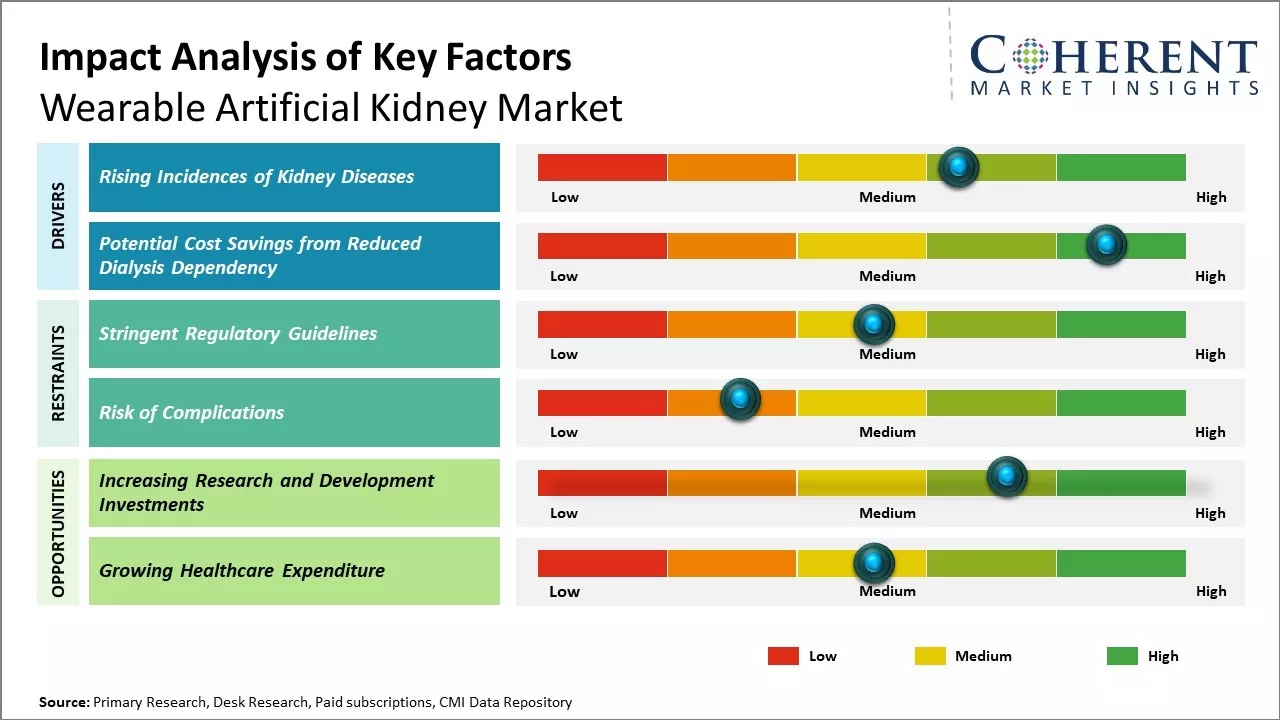
Discover market dynamics shaping the industry: Download Free Sample
Conventional dialysis requires patients to remain immobile during treatment, thus, negatively impacting quality of life. Wearable artificial kidneys could allow for portability and mobility, enabling dialysis to be administered at home or anywhere. This flexibility may address issues like long wait times for transplants by providing an alternative treatment option. As technology improves, wearable devices may meet the growing demand for kidney replacement therapies.
Market Driver – Rising Incidences of Kidney Diseases
Due to rising prevalence of chronic diseases such as diabetes and hypertension across both developed and developing nations, there has been rise in the incidences of kidney diseases as well. These chronic diseases are primary causes of end-stage renal diseases (ESRD), commonly known as kidney failure, where the kidneys permanently and severely lose their ability to function. According to estimates, approximately 750,000 patients suffer from ESRD globally, and the numbers are steadily increasing every year. Conventional treatment for ESRD involves costly kidney dialysis or kidney transplant, both of which have significant limitations and risks. While dialysis is a lifelong dependency for patients, transplant options are scarce due to lack of availability of donor kidneys. A wearable artificial kidney can potentially revolutionize the treatment landscape by offering patients an alternative which does not require dialysis or transplants. It would mimic the filtration functions of natural kidneys and allow continuous blood filtration outside of hospital settings. This could help to overcome limitations of current options and improve quality of life of ESRD patients. As the number of underlying reasons increases, there is an increasing demand for a workable therapy substitute. Wearable artificial kidney could witness strong demand in the coming years due to growing prevalence of kidney failure patient pool worldwide.
Market Concentration and Competitive Landscape
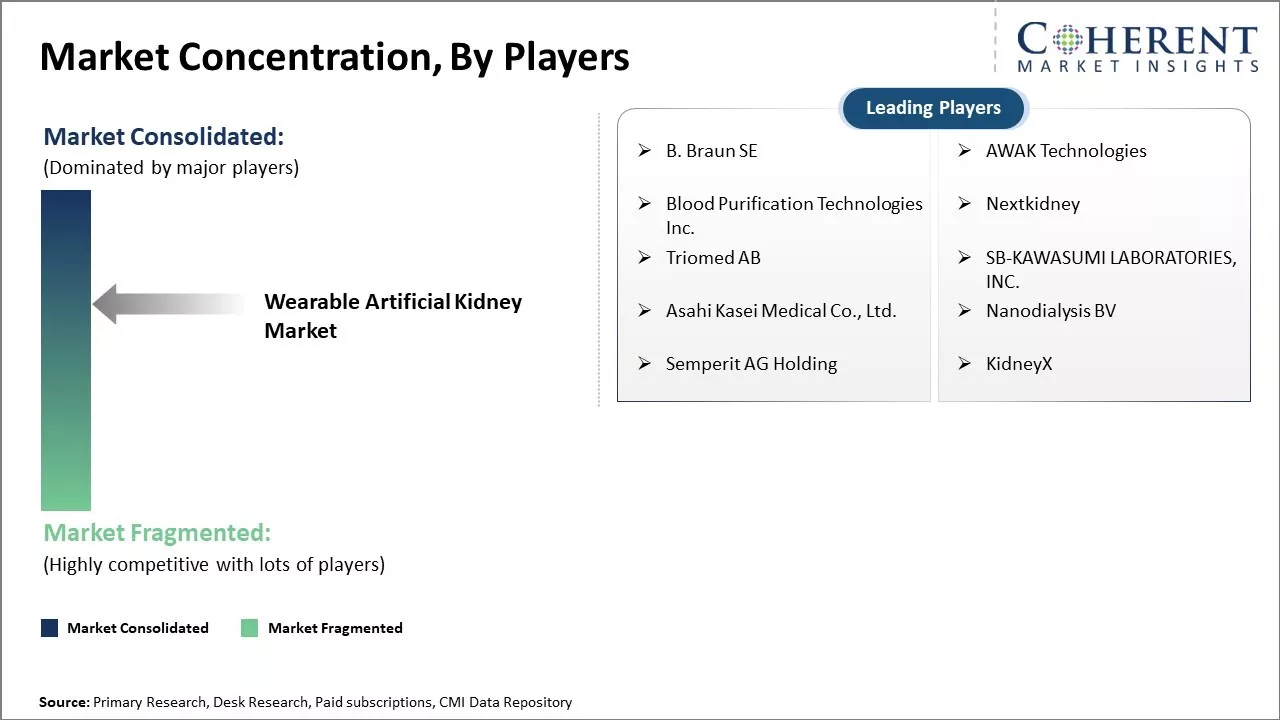
Get actionable strategies to beat competition: Download Free Sample
Potential Cost Savings from Reduced Dialysis DependencyKidney dialysis, which is the current standard of care for ESRD patients, poses a huge financial burden on healthcare systems globally. It requires patients to visit dialysis centers thrice every week for hours-long treatment sessions through their lifetime. The average annual cost of dialysis therapy per patient ranges anywhere between US$ 70,000 to US$ 90,000 depending on nation and healthcare system. In the long run, lifetime costs of dialysis add up to massive figures and place unsustainable pressure on payers. A fully functioning wearable artificial kidney offers potential to reduce or eliminate dialysis dependency, and can result in huge cost savings for patients as well as private and public insurers.
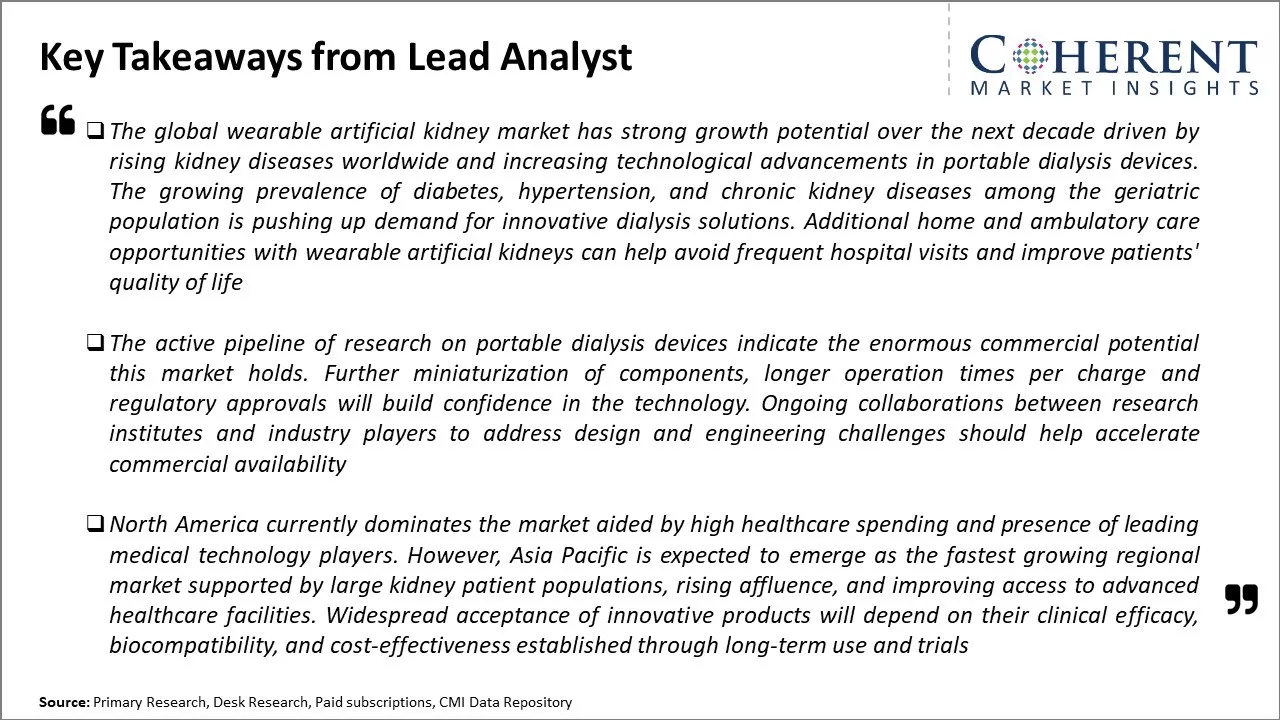
To learn more about this report, Download Free Sample
Market Challenge – Stringent Regulatory GuidelinesRegulatory bodies across the world have very high standards and strict protocols for approval of any new medical device or technology that interacts with the human body. Developing a wearable artificial kidney is an extremely complex task involving biomedical engineering as well as organ tissue regeneration. Such pathbreaking medical innovations require extensive research and testing to confirm long term safety and efficacy.
Market Opportunity – Increasing Research and Development Investments
Increasing adoption of inorganic growth strategies such as investments is expected to offer lucrative growth opportunities for the market growth. For instance, in January 2023, Nextkidney, a medical equipment company, announced that it had raised US$ 4.39 Mn for the development of portable artificial kidney.
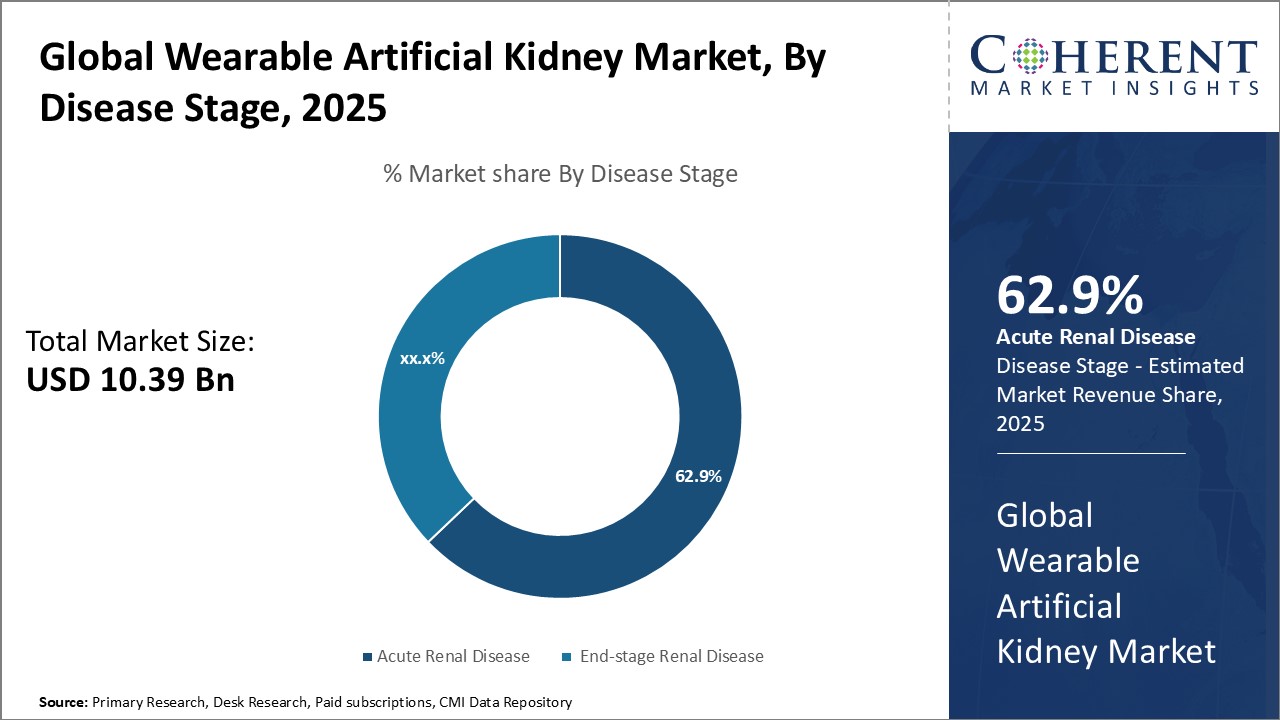
Discover high revenue pocket segments and roadmap to it: Download Free Sample
Insights, By Disease Stage: Advancements in kidney care drives the acute renal disease segment growthDisease Stage segment is sub-segmented into acute renal disease and end-stage renal disease. Acute renal disease segment is estimated to hold 62.9% of the market share in 2025 as advancements in medical technology and care have improved diagnosis and treatment for acute conditions. Doctors can now better identify risk factors for acute renal failure and monitor kidney function closely to prevent long-term damage. The development of effective medications and therapies also allows many cases to be resolved without transitioning to end-stage disease. The transient nature of acute conditions means that patients require ongoing but short-term therapy, and this makes wearable artificial kidneys quite suitable for this condition.
Insights, By Dialysis Type: Suitable Insurance Factors
Dialysis Type segment is sub-segmented into hemodialysis and peritoneal dialysis. Hemodialysis segment is estimated to hold 57.6% of the market share in 2025, owing to insurance factors. Hemodialysis requires frequent yet predictable treatment schedule, making costs easier for private and public plans to cover. Most nationalized healthcare programs now include hemodialysis under basic benefits packages. In contrast, peritoneal dialysis is a complex self-administered method with higher supply costs and many insurers hesitate to reimburse all associated expenses upfront. It also provides clinicians more flexibility to prescribe the modality best matching individual clinical needs, without regard to insurance hassles. Overall, stable reimbursement drives preference for hemodialysis and boosts the potential market for wearable artificial kidneys supporting home-based use of this dialysis type.
Insights, By End User: Aging Population Favors Hospital Adoption
End User segment is sub-segmented into hospitals, ambulatory surgical centers, dialysis centers, others. hospitals sub-segment is estimated to hold 39% of the market share in 2024, owing to demographic factors. Aging population worldwide increases the prevalence of chronic kidney diseases that often require dialysis. Elderly and frail patients often feel more comfortable receiving such intensive therapy within hospitals, where monitoring and immediate intervention are readily available should complications arise. Hospitals also maintain the infrastructure, expertise and regulatory compliance needed for disciplines like nephrology that involve complex procedures and strict safety protocols.
Regional Insights
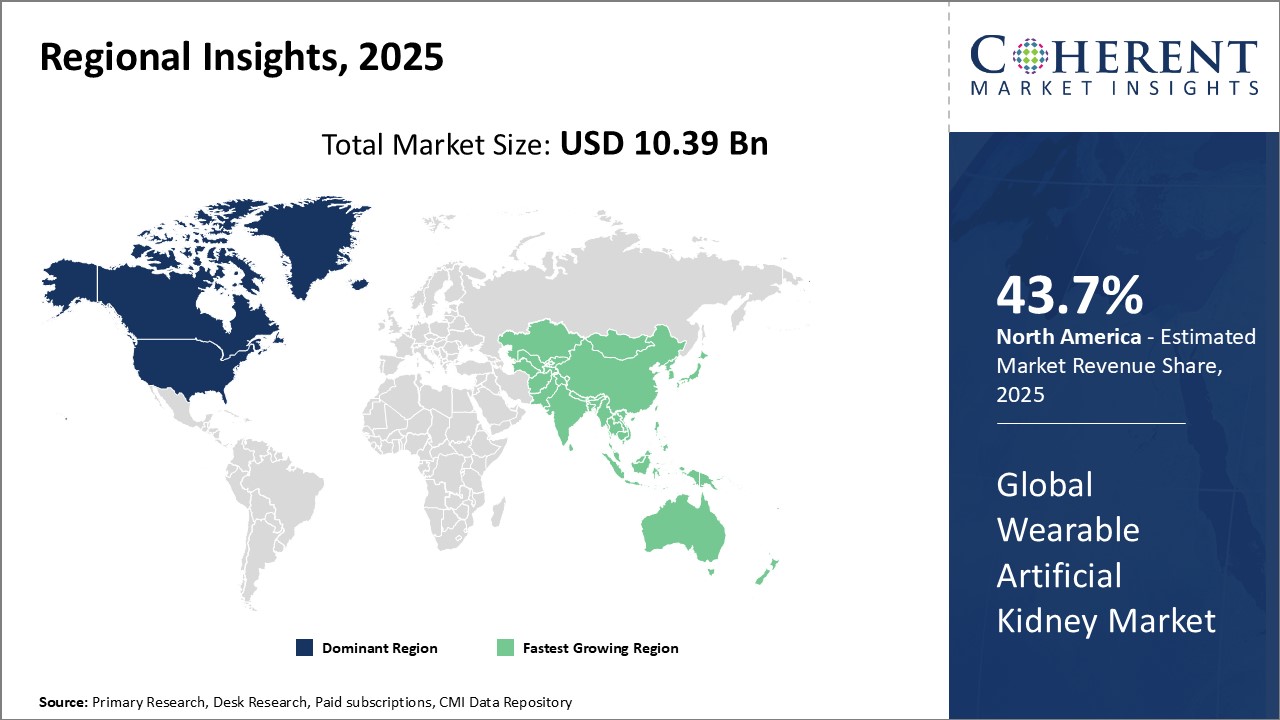
Need a Different Region or Segment? Download Free Sample
North America remains the dominant region in the global wearable artificial kidney market and is estimated to hold 43.7% of the market share in 2025. The presence of major manufacturers in the U.S and Canada such as SB-KAWASUMI LABORATORIES, INC., AWAK Technologies and others have provided definite advantage to the region over others. These companies have invested heavily in R&D over the years to develop advanced technologies related to wearable dialysis devices.
Asia Pacific market is witnessing fastest growth and emerging as new hotspot for wearable artificial kidney manufacturers. Countries like India, China and Japan are increasingly recognizing the burden of chronic kidney disorders With growing medical expenditures, Asia Pacific presents lucrative prospects, especially for small domestic players. Some giants are also shifting their focus towards markets like India for its large pool of kidney patients and growing preference towards wearable healthcare solutions. This makes Asia Pacific the fastest growing regional market for wearable kidney devices worldwide.
Market Report Scope
Global Wearable Artificial Kidney Market Report Coverage
| Report Coverage | Details | ||
|---|---|---|---|
| Base Year: | 2024 | Market Size in 2025: | USD 10.39 Bn |
| Historical Data for: | 2020 To 2024 | Forecast Period: | 2025 To 2032 |
| Forecast Period 2025 to 2032 CAGR: | 14.0% | 2032 Value Projection: | USD 26.01 Bn |
| Geographies covered: |
|
||
| Segments covered: |
|
||
| Companies covered: |
B. Braun SE, AWAK Technologies, Blood Purification Technologies Inc., Nextkidney, Triomed AB, SB-KAWASUMI LABORATORIES, INC., Asahi Kasei Medical Co., Ltd., Nanodialysis BV, Semperit AG Holding, KidneyX |
||
| Growth Drivers: |
|
||
| Restraints & Challenges: |
|
||
Uncover macros and micros vetted on 75+ parameters: Get instant access to report
Market Segmentation
- Disease Stage Insights (Revenue, USD Bn, 2020 - 2032)
- Acute Renal Disease
- End-stage Renal Disease
- Dialysis Type Insights (Revenue, USD Bn, 2020 - 2032)
- Hemodialysis
- Peritoneal dialysis
- End User Insights (Revenue, USD Bn, 2020 - 2032)
- Hospitals
- Ambulatory Surgical Centers
- Dialysis Centers
- Others
- Regional Insights (Revenue, USD Bn, 2020 - 2032)
- North America
- U.S.
- Canada
- Latin America
- Brazil
- Argentina
- Mexico
- Rest of Latin America
- Europe
- Germany
- U.K.
- Spain
- France
- Italy
- Russia
- Rest of Europe
- Asia Pacific
- China
- India
- Japan
- Australia
- South Korea
- ASEAN
- Rest of Asia Pacific
- Middle East
- GCC
- Israel
- Rest of Middle East
- Africa
- South Africa
- North Africa
- Central Africa
- North America
- Key Players Insights
- B. Braun SE
- AWAK Technologies
- Blood Purification Technologies Inc.
- Nextkidney
- Triomed AB
- SB-KAWASUMI LABORATORIES, INC.
- Asahi Kasei Medical Co., Ltd.
- Nanodialysis BV
- Semperit AG Holding
- KidneyX
Share
Share
About Author
Komal Dighe is a Management Consultant with over 8 years of experience in market research and consulting. She excels in managing and delivering high-quality insights and solutions in Health-tech Consulting reports. Her expertise encompasses conducting both primary and secondary research, effectively addressing client requirements, and excelling in market estimation and forecast. Her comprehensive approach ensures that clients receive thorough and accurate analyses, enabling them to make informed decisions and capitalize on market opportunities.
Missing comfort of reading report in your local language? Find your preferred language :
Transform your Strategy with Exclusive Trending Reports :
Frequently Asked Questions
EXISTING CLIENTELE
Joining thousands of companies around the world committed to making the Excellent Business Solutions.
View All Our Clients
